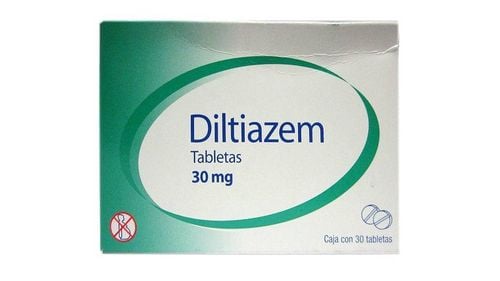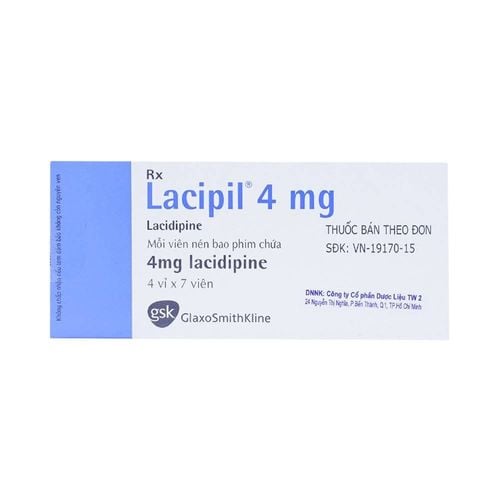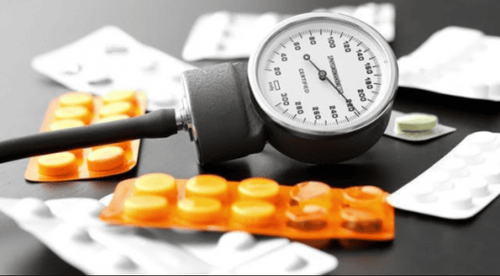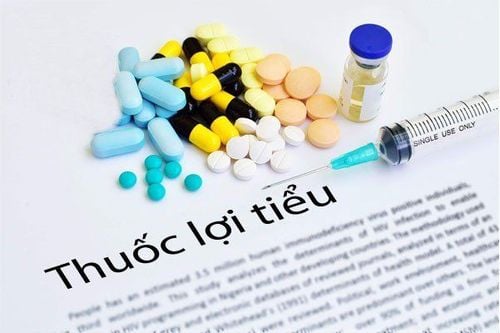This is an automatically translated article.
Vascam belongs to the group of drugs used to treat cardiovascular diseases, with the main ingredient being Amlodipine. This is a prescription drug, used in the treatment of high blood pressure. The following information about the drug Vascam, helps users better understand the uses and indications of Vascam in blood pressure.1. What is Vascam?
Vascam contains the main active ingredient Amlodipine, which is a calcium ion channel blocker (calcium ion antagonist), which inhibits the influx of calcium ions from the extracellular matrix into the smooth muscle cells and cardiac muscle, thereby causing the vessels to blood, the heart muscle is dilated. Amlodipine acts on vascular smooth muscle cells better than on cardiac muscle cells. As a result, the drug causes a decrease in peripheral vascular resistance, a decrease in cardiac output, and a decrease in blood pressure. Amlodipine does not adversely affect myocardial contractility, while reducing cardiac oxygen demand.
After oral administration 6-12 hours, amlodipine plasma concentrations peak, absolute bioavailability ranges from 64 to 90%, unchanged when taken with food. The drug is metabolized mainly in the liver (about 90%) and is excreted by the kidneys in the urine. Elimination from the blood is biphasic with a half-life of 30 to 50 hours. Stable drug concentration in the blood is achieved after 7-8 days of continuous use of the drug. Amlodipine clearance is decreased in the elderly and in patients with hepatic impairment.
2. Indications and contraindications of Vascam
2.1. Indications: Vascam is used to treat high blood pressure, chronic stable angina, because the drug reduces afterload, reduces the need for oxygen and energy for the myocardium. Myocardial ischemia due to Prinzmetal angina (variable angina). 2.2. Contraindications Do not use Vascam in the following cases:
Hypersensitivity to dihydropyridine derivatives or amlodipine and any excipients in the composition and content. History of shock including cardiogenic shock. Severe liver dysfunction. Severe aortic stenosis, because the drug can aggravate the gradient over the abnormal heart valve. Women who are / likely to become pregnant, women who are breastfeeding should not use the drug.
3. Dosage and how to use Vascam
How to use: The drug is taken orally. The patient should take the whole tablet, do not break the tablet, the time of taking may not be related to the meal.
Dosage: Adults: Take a single dose of 5mg once a day.
Maximum dose in 1 day is 10mg.
Overdose: rare, if drug overdose occurs, the patient should be monitored with electrocardiogram, symptomatic treatment. Gastric lavage, oral activated charcoal, correction of fluid and electrolyte replacement if necessary. In severe cases, the patient should be taken to a specialized medical facility for support.
Note: The drug has a long-lasting effect, so it only needs to be used once. Patients should take the medicine at 1 hour of the day.
Dosage adjustment must be directed by the doctor or depending on the clinical age and symptoms of the patient.
4. Undesirable effects when using Vascam
Treatment with Vascam is generally well tolerated, uncommon adverse reactions have been reported, including:
Nervous system: signs of dry mouth, increased sweating, increased muscle tone, neuropathy peripheral, paresthesia. Body as a whole: fatigue, weakness, back pain, fatigue, weight changes gain or lose. Cardiovascular system: hypotension, syncope, atrioventricular block. Endocrine: appearance of breast enlargement symptoms. Gastrointestinal: constipation, functional dyspepsia, pancreatitis, vomiting, diarrhea. Metabolism and nutrition: laboratory tests show hyperglycemia. Musculoskeletal: joint pain, muscle fatigue, cramps. Blood: leukopenia, purpura, thrombocytopenia... Psychiatric: depression, sexual disorder, insomnia, anxiety disorder. Respiratory system: dry cough, difficulty breathing, inflammation of the nasal mucosa. Skin and appendages: pruritus, urticaria, alopecia, skin discoloration, angioedema, erythema multiforme. Urinary: frequent urination, nocturia, dysuria. Special sensations: disturbance of taste, vision, tinnitus. Liver: Rarely increased liver enzymes.
5. Notes when using Vascam
Notes when using Vascam are as follows:
Patients need to inform their doctor, physician about the drugs and functional foods you are taking for advice on use, due to the interaction between Amlodipine with other drugs. medicine. Do not take the drug simultaneously with grapefruit juice, because it may change the hemodynamic effect in clinical. Use with caution in patients with severe bradycardia, heart failure, or cardiogenic shock due to the risk of mild negative myotropic effects and strong hypotensive effects. Monitor for symptoms of worsening heart failure in patients with left ventricular dysfunction receiving medications for angina pectoris. Patients with heart failure, when using the drug should be closely monitored or change drug class. Vascam should not be used in patients with systolic blood pressure less than 90 mmHg. Use with caution in patients with liver disease, the elderly. Amlodipine has been shown to be fetotoxic in animal studies, which should be taken into account when administering Vascam to pregnant women. Use for breastfeeding women, young children: The safety and effectiveness of the drug have not been clinically proven in these subjects. Clinical experience shows that the drug hardly reduces the patient's ability to drive and concentrate on operating machines. Above is information about the drug Vascam. The drug is widely used and popular in the pathology of hypertension. However, in order to achieve optimal results and minimize unwanted effects, patients need to follow the doctor's orders, do not arbitrarily take drugs without a prescription or quit suddenly without a doctor's advice. not specified.













